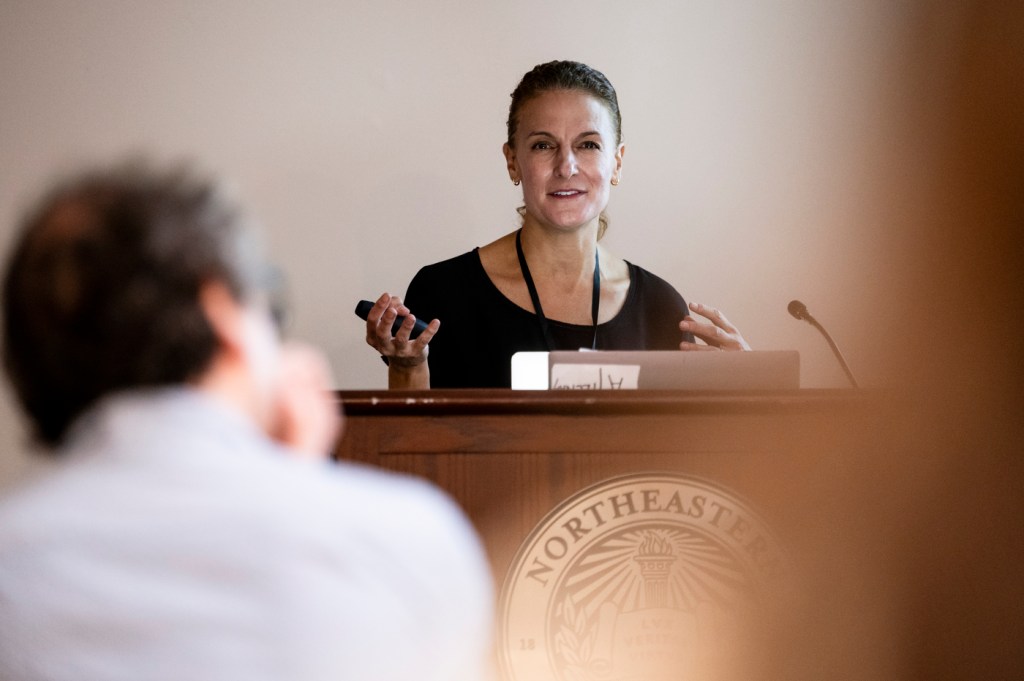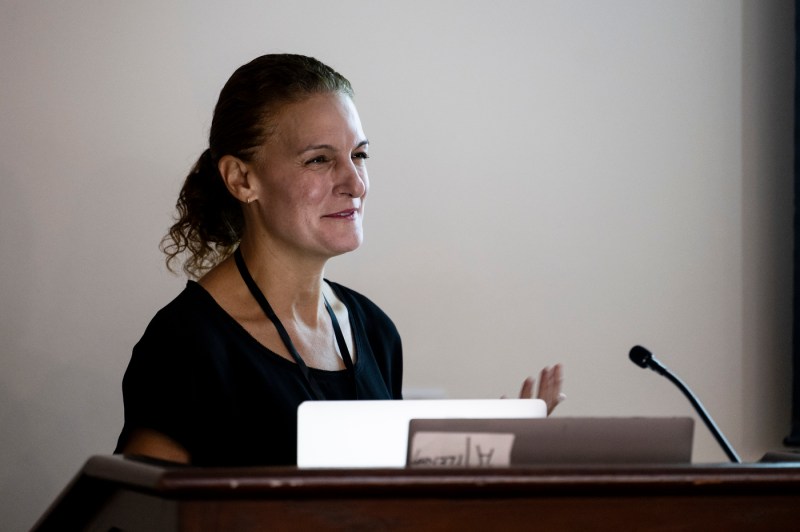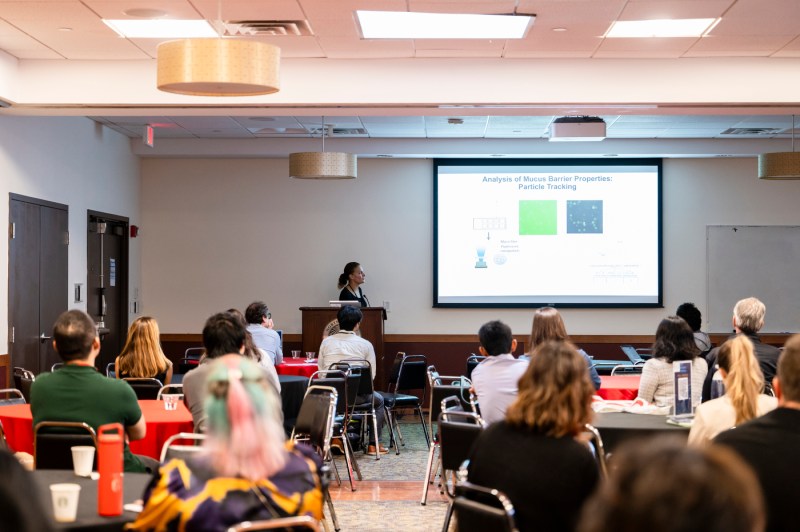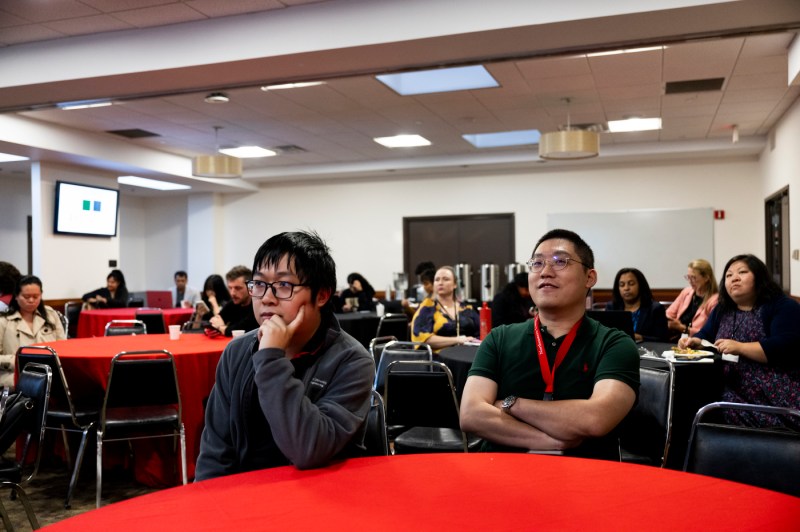How mucus is shaping drug delivery and medical research at Northeastern ‘gut lab’

Mucus is a thick, sticky substance that lines many parts of the body and plays an important role in protecting and lubricating vital tissues.
Mucus also plays an important role in how researchers develop drugs.
That topic is one of the key areas of interest for Rebecca Carrier, a Northeastern University professor of chemical engineering and the head of the university’s Advanced Drug Delivery Research Lab.
“So mucus, why is it so interesting?” Carrier asked recently in front of an audience at the Curry Student Center on the Boston campus. “It lines all our wet epithelial surfaces. It really forms this first barrier between us and the outside world.”
Carrier was one of the more than a dozen leading biomaterials experts who spoke during the recent Society for Biomaterials 2024 Northeast Symposium.
The two-day conference hosted by Northeastern brought together industry experts to discuss the biomaterial realm — from immune engineering and regenerative medicine to bioelectric materials and biointerfaces.
Mucus is a natural biomaterial and plays an important role in helping to smell, reproduce and have proper gut health, but it also plays an important role in how drugs are absorbed in the body, Carrier says.
At a macro level, a mucosal lining has a slim, shining appearance. At a microscopic level, it appears like “a continuous blanket of material.”
“As you zoom in looking down on that continuous blanket of material, you start to get a sense for this nano-porous network,” she says.




Northeastern professor Rebecca Carrier heads the university’s Advanced Drug Delivery Research Lab. Photo by Alyssa Stone/Northeastern University
In understanding how to navigate this network, it’s not only important to understand its physical characteristics but also its chemical nature, Carrier says.
Mucus is primarily composed of molecules called mucins and they communicate and come together in a number of different ways, including through disulfide bonds, hydrogen bonds, hydrophobic interactions, and electrostatic interactions.
“Those same types of interactions which occur between mucin molecules can also be important in controlling things that are trying to be transported through the mucus batter, like drug delivery systems and drugs,” she says.
Featured Posts
To study these interactions, Carrier and other researchers in her lab use a technique called “multiple particle tracking.”
The researchers collect intestinal mucus, put that mucus under a microscope, and add fluorescent entities into the mucus, often nanoparticles or sometimes bacteria, and track their movement through the mucosal gel using video microscopy.
“We then use an image analysis algorithm to track those particles so we can then analyze their trajectories and extract quantitative parameters that reflect the transport of the particles in the gel and the gel barrier properties,” she says.
Carrier first became interested in mucus when she was a scientist at Pfizer. While working to define drug formulations, she remembers a smaller company approaching Pfizer about permating the intestinal wall by “fluidizing the mucus barrier.”
“That was fascinating to me because traditionally if you look at the pharmaceutical literature, there’s very little discussion of the mucus barrier as being a significant barrier,” Carrier says. “It’s often referred to as an unstirred water layer, so just a passive diffusive barrier that things have to go through.”
So, researchers at Pfizer conducted experiments to test this theory to understand how these drugs interact within the barrier, and concluded that it was significant in impeding their passage.
Recently, researchers out of Northeastern’s Advanced Drug Delivery Research Lab have partnered with AbbVie Pharmaceuticals to understand how their drugs may be impacted by mucosal barriers.
“A lot of the work I do now is focused around problems that I saw working in industries,” she says. “So we do a lot of drug deliveries, not designing novel systems, but trying to mechanistically understand transport processes in the gut and how they’re affected by different drug delivery systems.”
Carrier’s research at her “gut lab” is focused on studying how a number of different outside factors may affect the mucus. Lipids, compounds found in many foods and drugs, for example, can significantly impact the barrier properties of mucus.
“We’ve been very interested in understanding how we can develop better model systems to study the mucosal barrier and in a more physiological context, ask some of these questions about the mucus barrier and how it’s changing with exposure to different systems and the ability of different systems to penetrate through it.”





